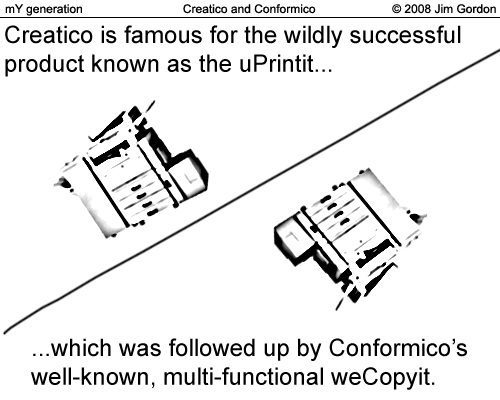|
|
|
Archive for October, 2008
Sunday, October 26th, 2008
See all mY generation posts here.

Posted in Culture, Innovation, mY generation | No Comments »
Sunday, October 26th, 2008
 Jim Stroup writes an amazing blog. He reads widely, thinks deeply and writes superbly—of course, it doesn’t hurt that we hold similar views on the subject of ‘leaders’. Jim Stroup writes an amazing blog. He reads widely, thinks deeply and writes superbly—of course, it doesn’t hurt that we hold similar views on the subject of ‘leaders’.
Last Thursday Jim wrote Clarifying leadership and supplied me with my quotes for today.
The first is from Peter Drucker, who said,
“Leadership is all hype. We’ve had three great leaders in this century – Hitler, Stalin, and Mao.”
Jim considers this the most sensible thing Drucker ever said about leadership and I agree. Jim goes on to say,
“He was right. Those guys had it all: vision, oratorical ability, relationship building skills, charisma, relentless focus, outside the box thinking, follower-attracting magnetism…Moreover they had the unconstrained maneuver room to give their leadership the untrammeled free rein that the modern movement’s gurus also insist is vital.”
Hmmm, free rein. Isn’t that what deregulation gave our fearless ‘leaders’ on Wall Street and in corporate America?
Your comments—priceless
Don’t miss a post, subscribe via RSS or EMAIL
Image credit image credit
Posted in About Leadership, Leadership Quotes, Quotable Quotes | 1 Comment »
Saturday, October 25th, 2008
 Even before the economic meltdown you heard constantly about all the reasons you needed to do things differently; all the problems inherent in hiring managing a four-generational workforce; all the new technology you needed in order to succeed. Even before the economic meltdown you heard constantly about all the reasons you needed to do things differently; all the problems inherent in hiring managing a four-generational workforce; all the new technology you needed in order to succeed.
In short, all the changes coming up, down and around the pike.
And as everyone know, change isn’t easy.
A few months ago IBM produced and excellent research study called The Enterprise of the Future (requires free registration), which was the basis of a series I wrote at Leadership Turn.
There’a new module out called Making Change Work and it offers up some interesting stats.
“Over a two-year period, the percentage of CEOs expecting substantial change climbed from 65 percent in 2006 to 83 percent in 2008 but those reporting they had successfully managed change in the past rose just 4 percentage points, up from 57 percent in 2006 to 61 percent in 2008… The major obstacles to implementing change in an enterprise are centered on people and corporate culture. Nearly 60 percent of the executives and project managers surveyed say changing mind sets and attitudes is the biggest challenge to implementing change in an enterprise, followed by corporate culture at 49 percent. These challenges were flagged as more important than shortage of resources, highlighting that these problems are seen as inherently more difficult to solve even if given sufficient resources. “
Lots of advice on inaugurating change and how to make it happen smoothly, but I think that this study is a great place to start. It has four sections
- Real Insights, Real Actions
- Solid Methods, Solid Benefits
- Better Skills, Better Change
- Right Investment, Right Impact
packed with solid information and useful information on what global bosses are doing.
The information is useful whether your company is global or local, because you’re both dealing with the same problems—people and the need to change corporate culture in order to survive and thrive.
Image credit
Posted in Business info, Communication, Culture, Leadership, Retention | No Comments »
Saturday, October 25th, 2008
 What a difference a year makes. Last year Wall Street Journal columnist Alan Murray wrote Revolt in the Boardroom: The New Rules of Power in Corporate America What a difference a year makes. Last year Wall Street Journal columnist Alan Murray wrote Revolt in the Boardroom: The New Rules of Power in Corporate America . (Excerpt) detailing the war between Boards, shareholders and CEOs. . (Excerpt) detailing the war between Boards, shareholders and CEOs.
He remembers the time when CEOs were all-powerful autocrats running top-down organizations under the auspices of Boards comprised friends and colleagues. The came the revolt and CEOs started being dumped right and left.
How large was the turnover tally last year and was it really that different from what it used to be?
Generally speaking, prior to the 1990s CEOs weren’t fired. During the Nineties Boards ousted a few high profile cases, such as GM, IBM, American Express, but by mid-2000 things really started changing and have continued apace—663 in 2004, 1322 in 2005, 1478 in 2006, but ‘only’ 1,356 2007.
Of course, not all were fired, some retired, some took outside offers, but a great number left by, or just before, Board request and some left in a very public perp walk.
By the time the book came out, six years after Enron, most of us thought we’d seen the worst; we believed that governance had changed and that Boards and investor activists had tamed CEO ego.
Many thought that it was a permanent shift in power away from CEOs, but it took only a year to show how inaccurate that analysis was.
It might be true when dealing with felonious intention, but when it comes to “maximizing shareholder returns” it seems like anything legal still goes.
But even slightly out of date, Revolt in the Boardroom is a good read—educational, entertaining and offering some unique insights into the corner office.
Your comments-priceless
Don’t miss a post, subscribe via RSS or EMAIL
Image credit
Posted in About Leadership, Culture, Ethics, Group Dynamics, Leading Factors, Reviews & Recommendations | No Comments »
Friday, October 24th, 2008
 Yesterday I said that creating a happy, i.e., productive, innovative, caring, workforce, was 80% MAP and 20% money-based employee support initiatives. Yesterday I said that creating a happy, i.e., productive, innovative, caring, workforce, was 80% MAP and 20% money-based employee support initiatives.
Everyone who writes or talks about management, or is interviewed as a role model, says the same thing in a variety of ways.
It boils down to what people want
- respect;
- honesty;
- shared commitment;
- clear communications as to where the company is going, how it’s going to get there, what’s expected of them and how it all fits together;
- an ethical culture; and
- authenticity throughout.
No details, they’re available in dozens of places, including this blog, along with plenty of how-to’s.
Now, let’s say that you’ve done your best to implement what you’ve learned (at whatever level you are), but you’re not getting the expected results. Productivity is still elusive, your people seem apathetic and you have more turnover than is healthy.
What’s wrong? What are you missing?
The answer is most likely deep within your MAP.
As you’ve read over and over, the key to all this is authenticity—translated that means you believe what you’re saying.
But having worked through this with hundreds of managers over the years I can say that frequently one or more of the “required” attitudes weren’t synergistic with their MAP.
They used the right words, even thought the right thoughts, but deep down they didn’t really believe—and their people knew it. Not ‘knew it’ as conscious thought, but knew it as a gut feeling; knew it because every time their manager said one particular thing they found themselves mentally squirming and didn’t know why.
What they did know was that it made them uncomfortable and worried them. The discomfort sat in the back of their mind nibbling away and their productivity went down, which made them still more uncomfortable and created fertile ground for any opportunity that came along.
The solution to this is simple, but very uncomfortable since it requires you to turn you eye inwards to find the offending MAP and then do what it takes to change it.
Now to the 20% that requires money.
Employee support usually falls in four categories.
Technology
When budgets are tight, new technology may be unavailable, but that’s just one piece of supporting your people and you can often work around at lest part of it. Brainstorm with your people and find solutions within the parameters with which you have to work.
Training
Training can be done if you get everybody involved. Here are four things to do within your organization that cost little to nothing.
- Build a useful library, both hard copy and online, that includes classic and current information and runs the gamut from traditional to controversial to off-the-wall. Encourage your people to read up on subjects that interest them, whether or not it directly applies to their expertise.
- Choose “topics of the month” based on both need and interest, and then encourage free-wheeling discussions on a regular basis.
- Adapt scheduling so people can start to use, and become proficient in, the new skills about which they are reading and talking.
- Support brown-bag classes (better yet, buy lunch if you can) in which they can teach their skills to others. Add cross-working assignments whenever possible to ensure cross-training.
Career opportunities
Providing career opportunities is easier than you think—and also more difficult. It requires you to do everything in your power to help your people acquire the skills necessary for them to take the next step in their chosen career path—that’s the easy part.
The difficult part is doing it even though you know that the person will leave, whether your group or the company, in order to take that step.
Rewards
The tighter the economy the more difficult it becomes to provide financial rewards—or so it seems. Overcoming this challenge goes back to authenticity and honesty.
You start by explaining clearly exactly what your financial constraints are, both yours as a manager and the company’s. Your people aren’t stupid, they’ll know if what you say is true. In the thousands of people I’ve talked with over my 25 years as a recruiter I never found one that didn’t have a pretty good idea of what was going on in their company.
Once that’s done, get creative. Ask your people for ideas and involve them in finding creative ways to provide incentives with what you do have to spend—just don’t do anything that isn’t synergistic with your MAP.
Doing all this is the best gift you can give your people—and yourself.
If you’d like to talk more about it feel free to call me at 866.265.7267—no charge, no joke.
Image credit
Posted in Business info, Communication, Culture, Motivation, Personal Growth, Retention | No Comments »
Friday, October 24th, 2008
I really dislike words that have no definition other than a different form of themselves.
Leader – a person or thing that leads.
Leadership – the position or function of a leader
Talk about something with no real meaning—except when looking at the man-hours spent teaching and writing about it or the hundreds of millions of dollars spent on acquiring it.
And I find the practice of identifying ‘leaders’ early in their careers particularly repugnant for two reasons.
1. The idea that you can identify future ‘leaders’ from their actions on the playground or in high school or during their initial working years is inaccurate at best and stupid at worst.
Those identified as kids are the ones who excel at getting noticed, love the spotlight, have a good story to tell and are typically attractive and mainstream. The nerds and misfits are rarely noticed as future ‘leaders’—think Steve Jobs.
Picking them out for special training during their first five years of work eliminates all those who work for bad bosses or for companies where entry level hires are grunts with no real responsibility.
Choosing them because they have an MBA is really ridiculous—all the degree proves is that they could afford grad school (either had the money or went into debt) and that they made it through. That’s it.
Further, the ‘early leader’ approach eliminates all those late bloomers giving them far less opportunities to excel.
The second reason is much worse.
2.Those ‘chosen’ start getting extra attention and mentoring from day one of being identified, so the traits that got them noticed get stronger. Stronger isn’t always better.
They are anointed, singled out for greatness, they are special.
Being special sets you apart; suddenly you’re better than the others and that means that there must be different rules for you because you’re special, better—and entitled. An attitude best summed up by Richard Nixon when he said, “When the President does it, that means that it is not illegal.”
And that sense of being anointed a ‘leader’ is partly responsible for the current debacle.
Your comments—priceless
Don’t miss a post, subscribe via RSS or EMAIL
Posted in About Leadership, Culture, Leadership Skills, Leading Stupidities, Personal Development | 7 Comments »
Thursday, October 23rd, 2008
Do you want your company/department/team to be successful? Highly productive? Envied and copied?
 Then make your people happy. Then make your people happy.
You may be as tired hearing that as I and others are of writing it, but it’s true and here’s still more proof,
“But growth companies also tend to have high-performance, high-reward cultures that expect a lot from the people that work there…How do they get that kind of effort without a lot of grousing and grumbling among the troops?…They support their people with tools to get the job done: money, training, the latest technology if that’s applicable. “I never saw a business grow by cost-cutting,” said Sam Simon, founder and CEO of Taylor-based Atlas Oil Co…
If everyone in the organization knows why things are being done, feels like his or her input is respected and sees a shared sense of commitment and sacrifice, the odds of surviving, prospering — even ending up on a list of Top Workplaces — are pretty good…
Also no surprise were the traits that stood out among companies with the happiest workers in surveys of 23,372 employees conducted for the Free Press by WorkplaceDynamics of Exton, Pa. Strong values and ethics, plus confidence in the company’s leader and direction, came out on top.”
And the key to all that, along with personal happiness, is very close. In fact, accomplishing all this is roughly 80% MAP (mindset, attitude, philosophy™) and 20% money-based actions.
But if it’s both cheap and easy why isn’t it done more?
Whoa! I didn’t say it was easy, I said it was 80% in your MAP, which means in your control.
You say you work for a jerk who isn’t interested in these intangibles?
OK, but where does it say that you have to act the same way?
You say that there’s no money available to provide the support, i.e. technology and training?
That can be gotten around when it’s really true.
But if the execs are flying first class, receiving bonuses, let alone hefty ones, and have a history of feeding cake to the masses while they dine on caviar and filet, then you may want to think through exactly why you’re there.
Come back tomorrow for specific way to accomplish both the MAP and the money-based initiatives.
Image credit
Posted in Business info, Communication, Culture, Innovation, Motivation, Retention | No Comments »
Thursday, October 23rd, 2008
 Leadership From The Inside Out: Becoming a Leader for Life is a second edition, published on the 10th anniversary of the original. Leadership From The Inside Out: Becoming a Leader for Life is a second edition, published on the 10th anniversary of the original.
What Kevin Cashman writes resonates whether you’re running a Fortune 100 corporation, raising a kid, or struggling to live a decent life.
As Cashman reminds us immediately, “we are the CEO’s of our own lives,” so if you read the book forgetting what you do or what you earn and focus on increasing your value to YOURSELF and those around you the book has great value.
However, if you read it as another part of a to-do list on getting ahead its value substantially declines.
Leadership From The Inside Out addresses understanding, growth and change in your MAP (mindset, attitude, philosophy™) as opposed to a set of steps and check-off points in how to be a ‘leader’.
Unhappily for some, Leadership From The Inside Out requires you to not only think, but think deeply. To gain real benefits from it you’ll need to mull, cogitate and then enable change in many levels of your MAP. Doing so is neither easy nor comfortable, but it is personally rewarding and extraordinarily valuable.
The book is still more valuable if you recast some of the thoughts to broaden its scope, e.g., where Cashman asks how authentic you are as a ‘leader’, ask yourself instead how authentic you are as a human being? How authentic in your other roles—parent, friend, spouse, teacher, landlord, plumber, etc.
The book is divided into seven ‘masteries’, they are
- personal mastery;
- purpose mastery;
- change mastery;
- interpersonal mastery;
- being mastery;
- balance mastery; and
- action mastery.
Cashman focuses on the fact that it’s not enough for you to master each of these, but that you must share them—passing them on to others within your world.
Although the book talks about executives, it’s not difficult to extend the intelligence to any level along with every-day life.
You always have to lead yourself, and you never know when you’ll have the opportunity to lead others, which makes the effort involved in truly utilizing what Cashman offers well worthwhile.
~~~~~~~~~~~~~~~~~~~~~~~~~
CandidProf’s schedule requires reducing posts to every other week. Read all of CandidProf here.
Your comments—priceless
Don’t miss a post, subscribe via RSS or EMAIL
Image credit
Posted in About Leadership, Change, Communication, Entrepreneurship, Leadership Choice, Leadership Resources, Leadership Skills, Personal Development, Reviews & Recommendations, What Leaders DO | 3 Comments »
Wednesday, October 22nd, 2008

leaders, too?
See a tribute to the meltdown leaders
Your comments—priceless
Don’t miss a post, subscribe via RSS or EMAIL
Image credit
Posted in About Leadership, Wordless Wednesday | No Comments »
Wednesday, October 22nd, 2008

And answer the question of what to do with them at Leadership Turn.
Image credit
Posted in Business info | No Comments »
|
 Subscribe to
Subscribe to
MAPping Company Success
About Miki 
Clarify your exec summary, website, etc.
Have a quick question or just want to chat? Feel free to write or call me at 360.335.8054
The 12 Ingredients of a Fillable Req
CheatSheet for InterviewERS
CheatSheet for InterviewEEs™
Give your mind a rest. Here are 4 quick ways to get rid of kinks, break a logjam or juice your creativity!
Creative mousing
Bubblewrap!
Animal innovation
Brain teaser
The latest disaster is here at home; donate to the East Coast recovery efforts now!
Text REDCROSS to 90999 to make a $10 donation or call 00.733.2767. $10 really really does make a difference and you'll never miss it.
And always donate what you can whenever you can
The following accept cash and in-kind donations: Doctors Without Borders, UNICEF, Red Cross, World Food Program, Save the Children
*/
?>About Miki
About KG
Clarify your exec summary, website, marketing collateral, etc.
Have a question or just want to chat @ no cost? Feel free to write
Download useful assistance now.
Entrepreneurs face difficulties that are hard for most people to imagine, let alone understand. You can find anonymous help and connections that do understand at 7 cups of tea.
Crises never end.
$10 really does make a difference and you’ll never miss it,
while $10 a month has exponential power.
Always donate what you can whenever you can.
The following accept cash and in-kind donations:
|
